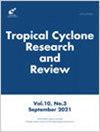双台风对西北太平洋上层海洋环境的影响
IF 4.1
4区 地球科学
Q3 METEOROLOGY & ATMOSPHERIC SCIENCES
引用次数: 0
摘要
2012年7月27日至8月4日,两个台风“索拉”和“达姆雷”横越西北太平洋(NPO)。在此期间,研究了海洋学响应。该研究利用QuickSCAT风的卫星数据、OISST的再分析数据和Argo数据,研究了海洋表面温度(SST)和混合层深度(MLD)对双台风的响应。2012年8月1日,台风达姆雷右侧由于混合作用,海温下降幅度最大,达3.6°C。台风达姆雷对台风绍拉有影响,致使海温降温减弱2.5℃。在双台风通过期间,台风“绍拉”附近的MLD变化最为明显,从15 m上升到85 m。Ekman泵送效应导致了次表层的变化,这改善了海温冷却,导致MLD加深。本文章由计算机程序翻译,如有差异,请以英文原文为准。
Impact of twin typhoons on the upper ocean environment across the Northwest Pacific ocean
Two typhoons, Saola and Damrey, moved across the Northwest Pacific Ocean (NPO) between July 27, 2012, and August 4, 2012. During this period, the oceanographic response was studied. The study examined variations in Sea Surface Temperature (SST) and Mix Layer Depth (MLD) in response to twin typhoons using satellite data from QuickSCAT wind, reanalysis data from OISST, and Argo data. On August 1, 2012, typhoon Damrey's right side experienced the greatest SST dip of 3.6 °C because of mixing. Typhoon Damrey had an influence on typhoon Saola, which caused a weaker SST cooling of 2.5 °C. During the passage of the twin typhoons, the area around typhoon Saola observed the most noticeable change in MLD, which went from 15 m to 85 m. The Ekman pumping effect led to modifications in the subsurface layer, which improved SST cooling and caused MLD deepening.
求助全文
通过发布文献求助,成功后即可免费获取论文全文。
去求助
来源期刊

Tropical Cyclone Research and Review
METEOROLOGY & ATMOSPHERIC SCIENCES-
CiteScore
4.60
自引率
3.40%
发文量
184
审稿时长
30 weeks
期刊介绍:
Tropical Cyclone Research and Review is an international journal focusing on tropical cyclone monitoring, forecasting, and research as well as associated hydrological effects and disaster risk reduction. This journal is edited and published by the ESCAP/WMO Typhoon Committee (TC) and the Shanghai Typhoon Institute of the China Meteorology Administration (STI/CMA). Contributions from all tropical cyclone basins are welcome.
Scope of the journal includes:
• Reviews of tropical cyclones exhibiting unusual characteristics or behavior or resulting in disastrous impacts on Typhoon Committee Members and other regional WMO bodies
• Advances in applied and basic tropical cyclone research or technology to improve tropical cyclone forecasts and warnings
• Basic theoretical studies of tropical cyclones
• Event reports, compelling images, and topic review reports of tropical cyclones
• Impacts, risk assessments, and risk management techniques related to tropical cyclones
 求助内容:
求助内容: 应助结果提醒方式:
应助结果提醒方式:


